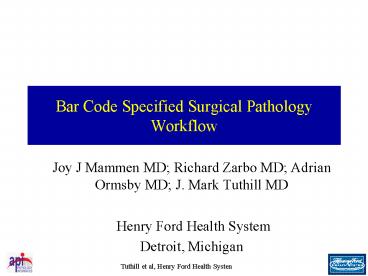Bar Code Specified Surgical Pathology Workflow - PowerPoint PPT Presentation
1 / 21
Title:
Bar Code Specified Surgical Pathology Workflow
Description:
Bar Code Specified Surgical Pathology Workflow Joy J Mammen MD; Richard Zarbo MD; Adrian Ormsby MD; J. Mark Tuthill MD Henry Ford Health System – PowerPoint PPT presentation
Number of Views:124
Avg rating:3.0/5.0
Title: Bar Code Specified Surgical Pathology Workflow
1
Bar Code Specified Surgical Pathology Workflow
- Joy J Mammen MD Richard Zarbo MD Adrian Ormsby
MD J. Mark Tuthill MD - Henry Ford Health System
- Detroit, Michigan
2
ContextIntroduction
- Automation of histopathology laboratory process
have been difficult due to the variability - specimen types
- the expression of disease in a given patient
- laboratory procedures required to arrive at
pathologic diagnosis. - A key challenge has been to automate specimen
labeling - Manual labeling is tedious, error prone, and
inefficient.
3
ContextFocus
- Revolutionary changes in materials available for
use in the histopathology laboratory have allowed
us to address this problem, automating cassette
and slide label generation - This decreases intra-lab identification errors
and improves efficiency by driving workflow using
bar code technology.
4
Patient Sample Identification
Biopsy/Label
Transport
Accession
Tissue Gross Exam
Processing
Embedding
Cutting/ Slide Label
Staining/Cover
Case Collation
Delivery
Microscopic Exam
Stain/Recut Order
Dictation
Transciption
Report Signout
SP processes at risk of mis-identification error
5
TechnologyCassette Creation
- Misys CopathPlus MHv 2.4 (Misys Healthcare,
Raleigh, NC) LIS - Custom interface to laser cassette etchers that
use Labelase software, both from General Data
(General Data, Cincinnati, OH). - 2 Dimensional barcodes etched on the cassettes
- Cassettes are read at the microtomy stations
using Dell Optiplex 745 PC (Dell, Roundrock, TX)
and Symbol barcode scanners (Motorola Inc.,
Holtsville, NY)
6
TechnologyLabel Generation
- Stain-resistant slide labels (Stainershield ,
General Data) on Intermec C4 (Intermec Inc.,
Everett, WA) direct thermal printers - A report was developed in CoPathPlus that
retrieves stain orders for each block.
7
DesignPrior to automation
- Tissue cassettes were printed with human-readable
identification details using the - Leica cassette printers (Leica Microsystems,
Bannockburn, IL) - Required re-entering demographic and case data
into dedicated software - After processing, sections were cut and mounted
onto slides manually labeled with the case
accession number and part number - Stains were performed based on electronic
requests that were available at the histology
department through the LIS - After staining, labels were batch printed from
the LIS and affixed onto the corresponding
slides.
8
DesignAutomation
- Two General Data laser cassette etchers
interfaced to CoPathPlus were placed at the
accessioning stations. - During accession, cassettes are etched with the
case number, patient name, part type
abbreviation, and a 2D barcode. - Once the block arrives at the microtomy station
equipped with a PC, barcode scanner and label
printer, the 2D barcode is scanned printing all
slide labels for that particular blocks stain
orders from the LIS.
9
DesignAutomation
- Labels are printed on Stainershield label
stock, applied to the glass slide and tissue
sections are cut and placed - Blocks are positively identified and slides
definitively labeled prior to staining. - Manual labeling is eliminated (reduced)
- Cross matching slides with labels is eliminated
- Slide labels include all relevant data as well as
a bar code (code 128C).
10
Accession Station U-shaped Cell
CoPath terminal Barcode label printer -Lab tag
-Specimen containers Lab tag scanner, bar code
reader Cassette etcher- 2D barcode
Microtome Station U-shaped Cell
CoPath terminal 2D Barcode reader -Individual
cassettes Slide label printer -Chemical
resistant slide labels -Print 1 cassette not
batch
11
(No Transcript)
12
(No Transcript)
13
(No Transcript)
14
(No Transcript)
15
(No Transcript)
16
Barcode Specified Surgical Pathology Workflow
1
2
Create Lab Tag Specimen Container Barcodes
Gross Tissue Cutting
Scan container barcode to open case in CoPath
CoPath
Scantron Lab Tag Imager
Accession
Specimens
2
Tray
CoPath
3
Cassette Etcher Create cassette barcode
Verify created container barcode with CoPath and
cassette ID
Verify original Lab Tag created barcode ID
Histology
Scan cassette barcode
Pathologist Signout
3
- Scan slide barcode to open case in CoPath -
View scanned lab tag in ThumbsPlus
4
Microtome
4
Create chemical resistant slide labels by
cassette barcode
1
Verify on cassette slide SP and pt. name with
CoPath
Verify patient name, SP on Lab tag, slide and
in CoPath
17
Patient Sample Identification
Biopsy/Label
Transport
Accession
Tissue Gross Exam
Processing
Embedding
Cutting/ Slide Label
Staining/Cover
Case Collation
Delivery
Microscopic Exam
Stain/Recut Order
Dictation
Transciption
Report Signout
SP processes targeted by barcode to reduce human
labor and mis-identification error
18
Results
- Most specimens received in the lab are currently
being processed using this system with slide
labels printed on demand at the microtomy
station. - Paper labels are still utilized for slides that
requiring microwave processing since the
StainerShiel labels undergo degradation - Time required for labeling prostate biopsies
having 36 slides was reduced from 20 minutes to
30-45 seconds
19
Results
- The CoPath interfaces saves time and eliminates
data entry errors related to re-keying data - This saves about two minutes per case.
- Thus this technology has
- saved time and effort as well as
- eliminating labeling errors
20
Results Post Bar Coding
All Surg Path Case Mis-identifications
62 reduction all misidentifications
45
85 reduction Block slide mis-ID
1.67
18
0.62
4 Pre-analytic derived
Barcode
2694 cases
2877 cases
21
Conclusions
- Integration of the barcode technology into the
histopathology labeling process has resulted in
process improvement, by saving time and reducing
errors.































